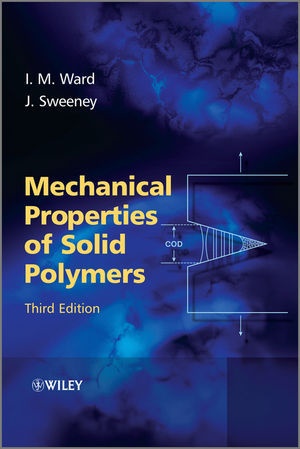En savoir plus
Informationen zum Autor Professor Ian M. Ward is an internationally recognized and well respected authority on this subject. Chair in Physics at Leeds University since 1970, he has gained a reputation as an outstanding scientist. He is also a co-founder of the British Polymer Physics Group and the winner of several awards, including the Glazebrook medal of the Institute of Physics (2004) and the Netlon award (2004) both given for his work in polymer physics. Professor John Sweeney holds a Personal Chair in Polymer Mechanics at the University of Bradford. He has researched in various areas of solid polymer behaviour, including viscoelasticity, fracture mechanics, shear banding, large deformations and nanocomposites. He is well known for his collaborations with Professor Ward and his association with the internationally recognized Polymer IRC (Interdisciplinary Research Centre). Klappentext Providing an updated and comprehensive account of the properties of solid polymers, the book covers all aspects of mechanical behaviour. This includes finite elastic behavior, linear viscoelasticity and mechanical relaxations, mechanical anisotropy, non-linear viscoelasicity, yield behavior and fracture. New to this edition is coverage of polymer nanocomposites, and molecular interpretations of yield, e.g. Bowden, Young, and Argon.The book begins by focusing on the structure of polymers, including their chemical composition and physical structure. It goes on to discuss the mechanical properties and behaviour of polymers, the statistical molecular theories of the rubber-like state and describes aspects of linear viscoelastic behaviour, its measurement, and experimental studies.Later chapters cover composites and experimental behaviour, relaxation transitions, stress and yielding. The book concludes with a discussion of breaking phenomena. Zusammenfassung Providing an updated and comprehensive account of the properties of solid polymers, the book covers all aspects of mechanical behaviour. This includes finite elastic behavior, linear viscoelasticity and mechanical relaxations, mechanical anisotropy, non-linear viscoelasicity, yield behavior and fracture. Inhaltsverzeichnis Preface xiii 1 Structure of Polymers 1 1.1 Chemical Composition 1 1.1.1 Polymerisation 1 1.1.2 Cross-Linking and Chain-Branching 3 1.1.3 Average Molecular Mass and Molecular Mass Distribution 4 1.1.4 Chemical and Steric Isomerism and Stereoregularity 5 1.1.5 Liquid Crystalline Polymers 7 1.1.6 Blends, Grafts and Copolymers 8 1.2 Physical Structure 9 1.2.1 Rotational Isomerism 9 1.2.2 Orientation and Crystallinity 10 References 16 Further Reading 17 2 The Mechanical Properties of Polymers: General Considerations 19 2.1 Objectives 19 2.2 The Different Types of Mechanical Behaviour 19 2.3 The Elastic Solid and the Behaviour of Polymers 21 2.4 Stress and Strain 22 2.4.1 The State of Stress 22 2.4.2 The State of Strain 23 2.5 The Generalised Hooke's Law 26 References 29 3 The Behaviour in the Rubber-Like State: Finite Strain Elasticity 31 3.1 The Generalised Definition of Strain 31 3.1.1 The Cauchy-Green Strain Measure 32 3.1.2 Principal Strains 34 3.1.3 Transformation of Strain 36 3.1.4 Examples of Elementary Strain Fields 38 3.1.5 Relationship of Engineering Strains to General Strains 41 3.1.6 Logarithmic Strain 42 3.2 The Stress Tensor 43 3.3 The Stress-Strain Relationships 44 3.4 The Use of a Strain Energy Function 47 3.4.1 Thermodynamic Considerations 47 3.4.2 The Form of the Strain Energy Function 51 3.4.3 The Strain Invariants 51 3.4.4 Application of the Invariant Approach 52 3.4.5 Application of the Principal Stret...
Table des matières
Preface xiii
1 Structure of Polymers 1
1.1 Chemical Composition 1
1.2 Physical Structure 9
2 The Mechanical Properties of Polymers: General Considerations 19
2.1 Objectives 19
2.2 The Different Types of Mechanical Behaviour 19
2.3 The Elastic Solid and the Behaviour of Polymers 21
2.4 Stress and Strain 22
2.5 The Generalised Hooke's Law 26
3 The Behaviour in the Rubber-Like State: Finite Strain Elasticity 31
3.1 The Generalised Definition of Strain 31
3.2 The Stress Tensor 43
3.3 The Stress-Strain Relationships 44
3.4 The Use of a Strain Energy Function 47
4 Rubber-Like Elasticity 61
4.1 General Features of Rubber-Like Behaviour 61
4.2 The Thermodynamics of Deformation 62
4.3 The Statistical Theory 65
4.4 Modifications of Simple Molecular Theory 72
4.5 The Internal Energy Contribution to Rubber Elasticity 80
4.6 Conclusions 83
5 Linear Viscoelastic Behaviour 87
5.1 Viscoelasticity as a Phenomenon 87
5.2 Mathematical Representation of Linear Viscoelasticity 92
5.3 Dynamical Mechanical Measurements: The Complex Modulus and Complex Compliance 103
5.4 The Relationships between the Complex Moduli and the Stress Relaxation Modulus 109
5.5 The Relaxation Strength 114
6 The Measurement of Viscoelastic Behaviour 119
6.1 Creep and Stress Relaxation 119
6.2 Dynamic Mechanical Measurements 123
6.3 Wave-Propagation Methods 127
7 Experimental Studies of Linear Viscoelastic Behaviour as a Function of Frequency and Temperature: Time-Temperature Equivalence 135
7.1 General Introduction 135
7.2 Time-Temperature Equivalence and Superposition 140
7.3 Transition State Theories 143
7.4 The Time-Temperature Equivalence of the Glass Transition Viscoelastic Behaviour in Amorphous Polymers and the Williams, Landel and Ferry (WLF) Equation 147
7.5 Normal Mode Theories Based on Motion of Isolated Flexible Chains 156
7.6 The Dynamics of Highly Entangled Polymers 160
8 Anisotropic Mechanical Behaviour 167
8.1 The Description of Anisotropic Mechanical Behaviour 167
8.2 Mechanical Anisotropy in Polymers 168
8.3 Measurement of Elastic Constants 171
8.4 Experimental Studies of Mechanical Anisotropy in Oriented Polymers 185
8.5 Interpretation of Mechanical Anisotropy: General Considerations 192
8.6 Experimental Studies of Anisotropic Mechanical Behaviour and Their Interpretation 198
8.7 The Aggregate Model for Chain-Extended Polyethylene and Liquid Crystalline Polymers 212
8.8 Auxetic Materials: Negative Poisson's Ratio 216
9 Polymer Composites: Macroscale and Microscale 227
9.1 Composites: A General Introduction 227
9.2 Mechanical Anisotropy of Polymer Composites 228
9.3 Short Fibre Composites 233
9.4 Nanocomposites 238
9.5 Takayanagi Models for Semi-Crystalline Polymers 241
9.6 Ultra-High-Modulus Polyethylene 250
9.7 Conclusions 255
10 Relaxation Transitions: Experimental Behaviour and Molecular Interpretation 261
10.1 Amorphous Polymers: An Introduction 261
10.2 Factors Affecting the Glass Transition in Amorphous Polymers 263
10.3 Relaxation Transitions in Crystalline Polymers 269
10.4 Conclusions 282
11 Non-linear Viscoelastic Behaviour 285
11.1 The Engineering Approach 286
11.2 The Rheological Approach 289
11.3 Creep and Stress Relaxation a

